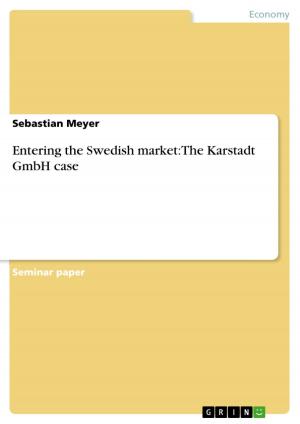Strategy, Structure, and Control of Multinational Enterprises in International Business Environments
Business & Finance, Management & Leadership, Management| Author: | Atilla Kibar | ISBN: | 9783638048521 |
| Publisher: | GRIN Publishing | Publication: | May 16, 2008 |
| Imprint: | GRIN Publishing | Language: | English |
| Author: | Atilla Kibar |
| ISBN: | 9783638048521 |
| Publisher: | GRIN Publishing |
| Publication: | May 16, 2008 |
| Imprint: | GRIN Publishing |
| Language: | English |
Seminar paper from the year 2006 in the subject Business economics - Business Management, Corporate Governance, grade: 74 / A (Excellent), Leeds Metropolitan University, course: International Business, 12 entries in the bibliography, language: English, abstract: Table of Content List of FiguresII 1Introduction1 1.1Context1 1.2Focus1 1.3Globalisation2 2Environment3 2.1Internal Environment4 2.1.1S.W.O.T.-Analysis4 2.2External Environment4 2.2.1P.E.S.T.-Analysis4 2.2.2Porter's Five Forces5 3Strategy7 3.1International Strategy7 3.2Global Strategy8 3.3Multidomestic Strategy9 3.4Transnational Strategy10 4Decision Making11 5Organisational Structures13 5.1Functional and Divisional Structures13 5.1.1International Division Structure14 5.1.2Area or Geographic Structure15 5.1.3Global Product Structure16 5.1.4Global Functional Organization17 5.1.5Matrix Structure18 6Coordination and Control Systems20 6.1Control Mechanisms21 7Case Study22 7.1Case: Nestlé22 7.2Case: Johnson & Johnson23 8Conclusion25 Bibliography26 1.1Context In the last 25 years of the twentieth century companies faced strong competition caused by technological revolutions, changing of product designs and manufacturing processes. Figure 1 indicates that FDI stock increased dramatically over the last decades. This implicates that multinational enterprises (MNEs) increasingly engage in international operations in order to create competitive advantages. Also governments are removing international restrictions and try to establish a common market by approximating the economic policies especially in the European Union. 1.2Focus This report focuses on the environment in which MNEs operate which determines the control strategies. After explaining these strategies this report will investigate organisational structures and control mechanisms which enables companies to coordinate and control their activities. In the last part the report will describe in a case study the strategies and structures of two 'global players': Nestle and Johnson & Johnson. 1.3Globalisation Nowadays the increasing 'globalisation' forces companies to compete on global markets. The aim of most enterprises is to make profits. Nationally focused companies that were not able to access foreign markets quickly enough were forced to act under increasing pressure threatening loss of market share or even acquisitions. The drivers of globalisation have (...)
Seminar paper from the year 2006 in the subject Business economics - Business Management, Corporate Governance, grade: 74 / A (Excellent), Leeds Metropolitan University, course: International Business, 12 entries in the bibliography, language: English, abstract: Table of Content List of FiguresII 1Introduction1 1.1Context1 1.2Focus1 1.3Globalisation2 2Environment3 2.1Internal Environment4 2.1.1S.W.O.T.-Analysis4 2.2External Environment4 2.2.1P.E.S.T.-Analysis4 2.2.2Porter's Five Forces5 3Strategy7 3.1International Strategy7 3.2Global Strategy8 3.3Multidomestic Strategy9 3.4Transnational Strategy10 4Decision Making11 5Organisational Structures13 5.1Functional and Divisional Structures13 5.1.1International Division Structure14 5.1.2Area or Geographic Structure15 5.1.3Global Product Structure16 5.1.4Global Functional Organization17 5.1.5Matrix Structure18 6Coordination and Control Systems20 6.1Control Mechanisms21 7Case Study22 7.1Case: Nestlé22 7.2Case: Johnson & Johnson23 8Conclusion25 Bibliography26 1.1Context In the last 25 years of the twentieth century companies faced strong competition caused by technological revolutions, changing of product designs and manufacturing processes. Figure 1 indicates that FDI stock increased dramatically over the last decades. This implicates that multinational enterprises (MNEs) increasingly engage in international operations in order to create competitive advantages. Also governments are removing international restrictions and try to establish a common market by approximating the economic policies especially in the European Union. 1.2Focus This report focuses on the environment in which MNEs operate which determines the control strategies. After explaining these strategies this report will investigate organisational structures and control mechanisms which enables companies to coordinate and control their activities. In the last part the report will describe in a case study the strategies and structures of two 'global players': Nestle and Johnson & Johnson. 1.3Globalisation Nowadays the increasing 'globalisation' forces companies to compete on global markets. The aim of most enterprises is to make profits. Nationally focused companies that were not able to access foreign markets quickly enough were forced to act under increasing pressure threatening loss of market share or even acquisitions. The drivers of globalisation have (...)















